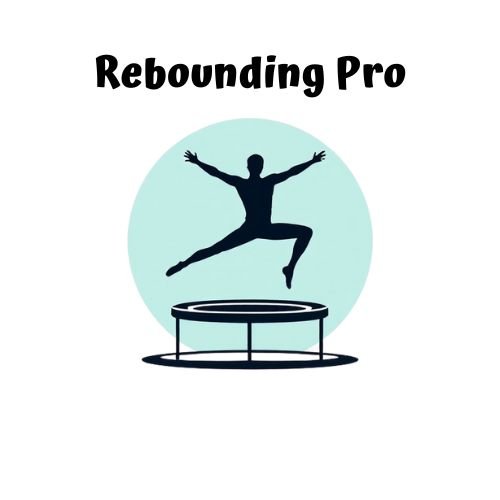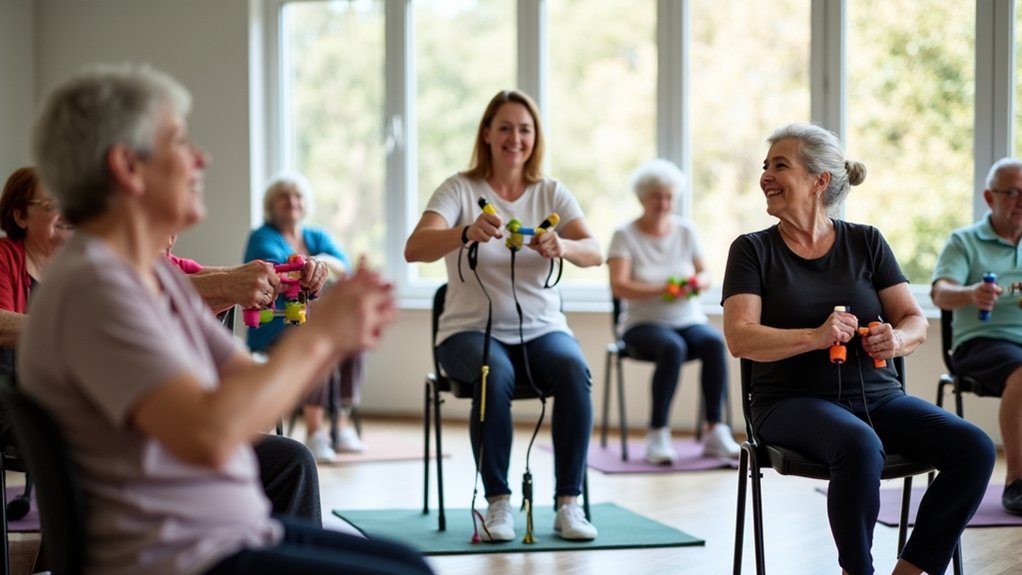Therapeutic jumping is a specialized exercise using controlled bouncing movements, often on mini-trampolines, to promote joint health. You’ll experience benefits like improved cartilage regeneration, increased joint lubrication, and strengthened supporting muscles with less impact than traditional exercises. The elastic surface absorbs up to 87% of impact forces while stimulating synovial fluid circulation—particularly helpful for arthritis sufferers. Safe techniques include “health bounces” that limit height while engaging your core. Discover how this low-impact approach might revolutionize your joint healing journey.
What Is Therapeutic Jumping For Joint Healing?

Therapeutic jumping represents a specialized form of exercise that harnesses controlled, high-impact movements to promote joint health and healing.
Unlike conventional advice to avoid impact, this approach recognizes that joints actually strengthen through appropriate stress and movement rather than rest alone.
When you engage in properly executed jumping exercises, you’re stimulating cartilage regeneration, increasing joint lubrication, and strengthening supporting muscles.
These benefits can be particularly valuable for those at risk of osteoarthritis. Research shows that high-impact training can improve patellar cartilage quality and reduce inflammation by enhancing circulation.
The key difference between harmful jumping and therapeutic jumping lies in proper technique, progression, and customization.
You’ll need to build foundational strength before attempting plyometric movements, ensuring your joints receive benefit rather than damage. However, overweight individuals should consider that excess weight can add 30-60 pounds of force on the knee with each step when planning their therapeutic jumping routine.
The Science Behind Therapeutic Rebounding
When you jump on a mini-trampoline, you’re engaging in more than just a fun activity—you’re harnessing powerful physiological processes that benefit your joints. The repetitive gravity changes during rebounding increase oxygen delivery to cells while strengthening them through mechanical stress. A NASA study found that the G-forces measured at the ankle during rebounding are more evenly distributed throughout the body compared to running. Unlike high-impact exercises, rebounding stimulates your lymphatic system without straining your joints, making it ideal for rehabilitation.
| Benefit | Mechanism | Application |
|---|---|---|
| Joint Protection | Low-impact elastic surface | Arthritis management |
| Improved Circulation | Enhanced lymph flow | Reduced inflammation |
| Neurological Enhancement | Balance challenges | Fall prevention |
| Muscle Strengthening | Rhythmic contractions | Rehabilitation |
| Cardiovascular Health | Efficient oxygen consumption | Low-stress aerobic training |
Research shows rebounding can be more efficient than running for oxygen consumption while delivering superior external work output—all with less strain on your body.
How Mini-Trampoline Exercises Benefit Joint Health

Mini-trampoline exercises offer remarkable benefits for joint health that extend far beyond simple bouncing. The elastic surface reduces joint impact by approximately 80% compared to walking or running on hard surfaces, acting as a shock absorber for your knees and ankles.
The elastic surface of a mini-trampoline cushions movement, reducing joint stress while providing a surprisingly effective workout.
When you rebound, you’re simultaneously strengthening multiple muscle groups around your joints, enhancing stability and reducing arthritis-related pain. This low-impact exercise mimics running without the harsh pounding effects of pavement on your body. This low-impact activity improves balance and coordination, with seniors experiencing up to 35% improvement in stability after consistent training.
Regular sessions stimulate bone density increases, particularly in fracture-prone areas like hips, while providing cardiovascular benefits.
You can safely progress from gentle walking to more intense movements, making mini-trampolines ideal for long-term joint protection while maintaining an effective workout regimen.
Therapeutic Jumping vs. Traditional Exercise for Arthritis
You’ll find therapeutic jumping creates less impact on your joints than traditional exercises like jogging or running on hard surfaces.
The springy surface of mini-trampolines absorbs up to 87% of impact forces, making it a gentler option for your arthritic joints compared to high-impact activities.
Regular rebounding exercise encourages synovial fluid circulation, which can improve joint lubrication and nourishment for those suffering from arthritis.
If you’re looking for joint-friendly alternatives, consider combining therapeutic jumping with low-impact options like swimming or cycling for a thorough arthritis management approach.
Impact Comparison
Although both therapeutic jumping and traditional exercise provide benefits for arthritis patients, they differ considerably in their impact on joint health and function.
Traditional exercises like walking, cycling, and aquatic activities produce minimal joint loading, making them safer initial options for pain management.
In contrast, therapeutic jumping creates forces 7-10 times your body weight, which can strengthen muscles more effectively but poses higher joint stress risks. This jumping approach measures power and force capabilities that traditional assessments might miss, potentially detecting functional decline earlier. Exercise training significantly improves physical function by enhancing muscle strength, which is crucial for stabilizing osteoarthritic joints.
While low-impact exercises remain the foundation for arthritis management, properly modified jumping protocols may offer complementary benefits through enhanced muscle strength and shock absorption.
Your individual condition requires careful clinical assessment before incorporating high-impact activities to guarantee they’ll improve rather than worsen joint health.
Joint-Friendly Alternatives
Four joint-friendly alternatives exist for arthritis patients seeking the benefits of therapeutic jumping without excessive joint stress.
Rebounding on mini trampolines offers low-impact cardio while absorbing ground reaction forces, protecting your joints while improving synovial fluid circulation. Research shows that progressive high-impact exercise can actually improve cartilage health when properly supervised and tailored to individual needs.
Aquatic therapy utilizes water’s buoyancy to reduce weight-bearing stress, allowing you to perform exercises with minimal joint pain. The warm water enhances flexibility and reduces stiffness.
Resistance training strengthens muscles surrounding affected joints, improving stability and reducing mechanical stress. This can be customized with supportive equipment to safely increase intensity.
Low-impact aerobic exercises complement these options, allowing you to progress from gentle strength-building to more dynamic movements under proper supervision, all while maintaining joint health and function.
Getting Started With Joint-Friendly Rebounding

Starting on a joint-friendly rebounding journey requires careful attention to form and progression.
Begin with health bounces—gentle movements that keep your feet mostly in contact with the mat—while maintaining a slight bend in the knees with knees tracking over your middle toes.
Always distribute your weight evenly across your feet and engage your core to protect your lower back.
Start with just a few minutes 3-4 times weekly, gradually increasing as your body adapts. Incorporate gentle movements like side steps and heel digs rather than high-impact moves that stress joints.
For maximum safety, consult your healthcare provider before beginning, especially if you have existing joint conditions.
Consider using a compression sleeve on both knees for additional support during your rebounding sessions.
Consider using a rebounder with handlebars for added stability, and always prioritize proper warm-up and cool-down routines to protect your joints.
Measuring Progress: Jumping Mechanography in Clinical Settings
You’ll find jumping mechanography offers precise assessment of your muscle function through specialized protocols that measure power output, jump height, and weight-corrected force.
Your functional improvements can be quantified reliably with this technology, which boasts excellent test-retest reliability with ICCs of 0.88-0.93.
Unlike traditional functional tests such as chair rise or SPPB, jumping mechanography provides more sensitive measurements to track your healing progress over time.
Recent studies have demonstrated that jumping mechanography shows very good inter-rater reliability across multiple parameters in both adults and children.
Assessment Protocols Explained
While traditional joint assessment methods rely on subjective measures, jumping mechanography offers clinicians a powerful quantitative approach to track therapeutic progress with remarkable precision.
You’ll perform standardized two-legged countermovement jumps on a force platform while technicians measure your maximum power, force, velocity, and jump height. The Esslinger Fitness Index will compare your results to reference values.
The assessment typically involves multiple jumps to guarantee reliable data, with minimal learning curve after initial familiarization. The protocol is safe even for older adults with osteoporosis or previous fractures, with no reported adverse events.
Jumping mechanography excels at detecting subtle changes in neuromuscular function that indicate healing or deterioration, making it invaluable for monitoring rehabilitation progress and adjusting treatment plans accordingly. Recent studies have shown high correlation between jumping mechanography and timed function tests, providing complementary insights for comprehensive patient assessment.
Quantifying Functional Improvement
Moving from assessment protocols to practical applications, jumping mechanography (JM) brings remarkable precision to measuring therapeutic progress in clinical settings.
You’ll benefit from JM’s excellent test-retest reliability, with correlation coefficients of 0.88-0.95 for key metrics like peak power and jump height—significantly outperforming traditional tests like chair rise and gait speed assessments.
When you undergo therapeutic jumping, clinicians can track your rehabilitation through objective measurements of force, velocity, power, and jump height.
These parameters strongly correlate with everyday functional abilities and fall risk. The Esslinger Fitness Index provides an age- and sex-adjusted comparison to normative populations, helping you understand your progress in context.
For joint rehabilitation specifically, serial JM testing offers quantitative evidence of healing, allowing your therapist to make data-driven adjustments to your treatment plan. Clinicians can now reference age-related centiles for German children when evaluating pediatric rehabilitation progress.
Comparison With Traditional Tests
How does jumping mechanography stack up against traditional assessment methods? When comparing reliability and sensitivity, JM consistently outperforms many conventional tests you might be familiar with.
This advanced assessment tool offers several advantages:
- Higher reliability coefficients (ICCs of 0.88-0.93) compared to chair rise (0.81) and gait speed (0.76)
- Objective quantification of muscle power rather than subjective or self-paced efforts
- Excellent inter-rater reliability with ICCs above 0.98, reducing examiner-dependent variables
- Strong correlation with traditional functional tests (r≈0.6 with walking and chair rising)
- Safe and feasible for 96% of community-dwelling older adults with proper supervision
This enhanced measurement precision allows your healthcare provider to detect subtle changes in function that might be missed by traditional assessments. Recent studies with DMD patients demonstrate jumping mechanography provides valuable insights into higher power output movements, complementing traditional assessments like the 6-minute walk test.
Case Studies: Cartilage Regeneration Through Controlled Impact
Remarkable success stories have emerged from clinical applications of therapeutic jumping protocols in patients with cartilage damage.
You’ll find that controlled impact forces create favorable mechanical stress that activates mechanosensitive channels in cartilage cells, triggering repair mechanisms.
In one documented case, a 42-year-old runner with knee cartilage degeneration experienced 68% improvement after eight weeks of therapeutic jumping combined with biomaterial injections.
The regimen enhanced TGF-β production, creating an ideal regenerative environment. This approach complements newer treatments that use bioactive peptides to mimic cartilage’s natural environment through complex molecular networks.
TGF-β activation creates a powerful biochemical cascade, establishing optimal conditions for cellular rebuilding within damaged joint tissues.
Another study followed five athletes with shoulder cartilage injuries who showed accelerated healing when therapeutic jumping was integrated with MSC treatments.
The controlled stress patterns influenced mesenchymal stem cell differentiation, promoting chondrogenic development.
These cases demonstrate how precisely calibrated mechanical stimulation can transform the joint microenvironment and facilitate natural cartilage regeneration.
Adapting Rebounding Techniques for Different Joint Conditions
You’ll need specific rebounding adaptations based on your joint condition, whether dealing with knee pathologies, ankle instabilities, or hip limitations.
For knee issues, focus on controlled mini-jumps with proper alignment and reduced height, while ankle rehabilitation requires progressive balance training on stable surfaces before advancing to dynamic rebounds. Those with jumper’s knee should be particularly cautious as the repetitive stress from rebounding could aggravate patellar or quadriceps tendon inflammation.
Hip-safe techniques involve limiting lateral movements, maintaining neutral pelvis position, and incorporating targeted gluteal strengthening between rebounding sessions to protect vulnerable hip structures.
Knee-Specific Rebounding Modifications
When adapting rebounding exercises for knees that need special attention, several modifications can transform standard trampoline workouts into therapeutic interventions.
Focus on creating a foundation of stability while gradually building strength through controlled movements.
- Maintain constant foot contact with the mat using “health bounces” that limit height to 1-2 inches, reducing joint impact while still activating muscles.
- Engage your core throughout all movements to distribute forces away from your knees.
- Use alignment checks to verify your knees track over your middle toes, preventing medial/lateral strain.
- Incorporate compression gear like knee sleeves to enhance proprioceptive feedback during rebounding.
- Progress gradually by increasing session duration by only 5-10% weekly, prioritizing proper form over intensity.
This low-impact exercise is particularly beneficial during rehabilitation as the reduced impact force experienced on a rebounder is approximately one-sixth of what you would feel stepping on pavement.
Ankle Strength Protocols
While knees often receive the most attention in rebounding therapy, the ankles serve as the primary shock absorbers during jumping activities. Developing ankle strength is vital for effective therapeutic jumping.
Begin with small, two-legged jumps before progressing to unilateral hopping and jump rope exercises. Incorporate single-leg box pattern jumps in multiple directions to challenge stability. You’ll also benefit from hop-to-stabilization drills that enhance eccentric strength. Since ankle injuries account for 15% of sport-related injuries annually, these progressive jumping exercises are crucial for preventing recurrence.
Complement jumping with resistance band exercises targeting dorsiflexion, inversion, and eversion movements. Aim for 3 sets of 15 repetitions with 3-5 second holds per movement.
Don’t neglect range of motion work – include calf stretches and ankle rockers to improve dorsiflexion.
Balance training using single-leg exercises and unstable surfaces will further enhance proprioception, which is essential for ankle stability during jumping activities.
Hip-Safe Bouncing Techniques
Hip conditions require specialized attention when integrating rebounding exercises into therapeutic regimens. Your bouncing technique should be modified based on your specific hip condition to guarantee healing rather than harm.
- For hip impingement or FAI, keep bounces gentle and avoid deep knee bends that could irritate the joint.
- If you’re managing arthritis, focus on low-impact, controlled bounces to improve circulation and reduce stiffness.
- Post-hip replacement patients should start with minimal bouncing, holding a support bar, and only progress under medical supervision.
- Those with labral tears need to avoid twisting motions while on the rebounder.
- Always warm up thoroughly before bouncing and stop immediately if you experience increased pain.
When incorporating rebounding for piriformis syndrome, maintain external rotation of the hip during gentle bounces to prevent aggravation of symptoms.
Using a Bellicon trampoline or quality rebounder with proper supportive gear can maximize benefits while protecting your healing joints.
Equipment Selection for Optimal Joint Protection
Selecting appropriate equipment stands as the cornerstone of effective therapeutic jumping programs aimed at joint healing.
You’ll want to prioritize gear with far-infrared reflective materials that enhance circulation and reduce joint stiffness during recovery. Back on Track products utilize technologies that stimulate circulation by reflecting body energy as far-infrared energy. Look for devices featuring pneumatic brake systems that minimize landing impact and protect weight-bearing joints from excessive force.
Consider incorporating air back braces, knee supports, or ring splints to stabilize vulnerable joints while jumping.
The best equipment includes adjustable resistance controls that allow you to customize intensity based on your body’s needs. Durable steel construction prevents wobbling that could stress joints, while ergonomic platforms guarantee proper biomechanics.
For rehabilitation purposes, choose devices offering partial bodyweight support and closed-chain kinetic platforms that minimize shear forces on healing joints.
Building a Progressive Therapeutic Jumping Routine
Because joint healing requires methodical care, a well-structured therapeutic jumping routine must progress gradually through distinct phases. Before beginning, you’ll need medical clearance to guarantee safety.
Start with Phase 1 exercises like double-leg hops on mini-trampolines, then advance to Phase 2’s side-to-side movements only when you’ve mastered the basics without pain.
- Begin with 15-20 minutes of aerobic warm-up (cycling or jogging)
- Limit sessions to twice weekly for proper recovery
- Land softly on the balls of your feet to minimize impact
- Progress to single-leg hops only after demonstrating stability
- Report any knee pain immediately to modify your routine
This gradual progression mirrors effective patellar tendinopathy protocols that transition from isometric exercises to more dynamic movements. As you advance through each phase, you’ll gradually incorporate more complex movements like 90° turns and obstacle navigation, always prioritizing proper technique over intensity.
Synovial Fluid Dynamics During Rebounding Exercises
Synovial fluid, often overlooked as a critical component of joint health, plays a fundamental role in the efficacy of rebounding exercises. When you bounce on a rebounder, you’re creating gentle compression-decompression cycles that pump synovial fluid throughout your joints. This motion enhances nutrient delivery to cartilage while removing metabolic waste.
The vertical acceleration forces during rebounding stimulate synovial fluid movement across cartilage surfaces without the damaging impact of hard-surface exercises. Your joints experience approximately 80% less stress on a rebounder compared to jogging, while still receiving the mechanical stimuli needed for healthy fluid dynamics. The Health Bounce technique emphasizes keeping feet low to maximize joint benefits while minimizing strain.
This rhythmic bouncing also improves lymphatic drainage and microcirculation, indirectly supporting synovial replenishment and maintaining the fluid’s lubricating properties—essential for pain-free movement and long-term joint health.
Combining Therapeutic Jumping With Other Recovery Methods
While therapeutic jumping offers substantial benefits on its own, its healing potential multiplies when strategically combined with complementary recovery methods.
You’ll experience faster recovery and more sustainable results when integrating multiple therapeutic approaches alongside your rebounding exercises.
- Manual therapy techniques like Motion-Specific Release address root biomechanical issues causing joint problems.
- Resistance training strengthens muscles surrounding joints, improving stability and reducing load.
- Aquatic therapy provides low-impact conditioning while warm water increases circulation.
- Stretching exercises enhance joint flexibility and range of motion, alleviating stiffness.
- Progressive rehabilitation phases incorporate isometric, eccentric/concentric, and plyometric exercises to safely rebuild tendon loading capacity.
This integrated approach can achieve remarkable success rates (around 90%) in reducing pain and restoring function by simultaneously addressing soft tissue restrictions and muscular conditioning.
Maintaining proper nose breathing techniques during rebounding exercises promotes calmness and prevents over-stressing the body during rehabilitation sessions.
Frequently Asked Questions
Can Therapeutic Jumping Worsen Existing Bone Spurs?
Yes, therapeutic jumping can worsen your existing bone spurs because it increases mechanical stress on affected joints. You’ll likely experience more pain and inflammation if the impact repeatedly irritates spurs in weight-bearing areas.
How Does Age Affect the Recovery Timeline From Therapeutic Jumping?
As you age, your recovery timeline from therapeutic jumping lengthens. You’ll need more time for muscle adaptation and cartilage healing—potentially 6-12 months versus shorter periods for younger individuals. Progress becomes more gradual but remains possible.
Is Therapeutic Jumping Covered by Health Insurance Plans?
Most health insurance plans don’t automatically cover therapeutic jumping. You’ll need a doctor’s prescription, documentation of medical necessity, and prior authorization. Check your specific plan details and consider FSA/HSA alternatives if coverage is denied.
Can Children With Joint Issues Benefit From Therapeutic Rebounding?
Yes, your child can benefit greatly from therapeutic rebounding. It improves joint mobility, strengthens muscles, reduces pain, enhances coordination, and supports sensory development while placing minimal stress on their developing joints.
Are There Alternatives for Those With Vestibular Disorders?
Yes, if you have vestibular disorders, you can try aquatic exercises, seated bouncing on therapy balls, strength training without jumping, low-impact aerobics like walking or cycling, and balance-friendly tools with proper support.
In Summary
You’ve now discovered the gentle power of therapeutic jumping for joint health. By integrating rebounding into your routine, you’re stimulating synovial fluid circulation while minimizing impact. Start with proper equipment, build gradually, and combine with complementary therapies for best results. Whether you’re managing arthritis or preventing future issues, you’ll find this low-impact approach offers significant benefits your joints will thank you for.





Leave a Reply